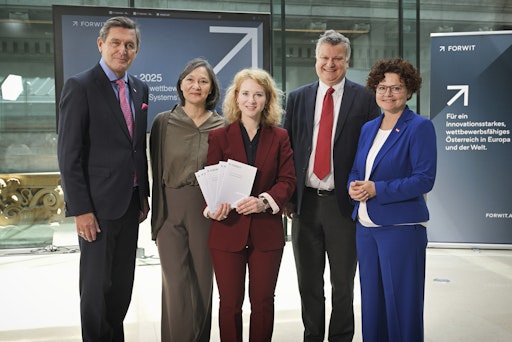On Monday, the Council for Research, Science, Innovation and Technology Development (Forwit) presented the FTI-Monitor 2025that provides information about the current performance of the Austrian FTI system. In addition to the latest findings on national innovation processes, the presentation was in particular the two new areas that have been added this year Competitiveness in FTI and Artificial intelligentz focused on.
Austria’s national strengths do not automatically bring top international positions
An analysis carried out by the WIFO on behalf of the Forwit illuminates how many patents in Austria are registered in various key technologies and how strongly the country specializes in it.
It shows that in recent years, Austria’s performance has improved significantly in the key technologies photonics, advanced materials and quantum technology – both in the number of patents and the degree of specialization. For example, the country is one of the international top 5 in photonics in both aspects. In the areas of IT for mobility and internet of things, there is also progress in specialization. However, the country often falls back in terms of international importance and citation frequency of the patents – an indication of a lower economic and technological importance. Countries with a significantly higher number of large technology -intensive companies such as Switzerland, the USA or Japan are usually better positioned here, sometimes develop faster and specialize more, so that Austria’s internal national strengths do not automatically lead to global top positions.
„For Austria – but also Europe – the goal must be to become internationally competitive in key technologies. If you can keep up in the technology competition runs, you can keep up anywhere. Because such technologies are geo -economically and economically significant cross -sectional topics that need and affect all areas of society – from education and social affairs to science to business, politics, security and defense. Strength in key technologies can therefore also be seen as a product of the strength of an entire society
“, Sylvia Schwaag Serger, deputy chairwoman of the forward.
Companies see more barriers for the use of AI
As such a broad cross -sectional technology, artificial intelligence must therefore also be used by companies in a meaningful and effective manner in order to keep up internationally. In the entrepreneurial use of artificial intelligence (AI), Austrian companies collect, but in total they only reach 73 % of the performance level of the innovation Leaders.
In 2024, almost 20 %-and thus around twice as many as in 2023-used the Austrian companies of ten employees at least one AI technology. This is above the EU average, but below the level of the European innovation Leaders Denmark, Sweden, Finland and the Netherlands, where around a quarter of the companies use AI. With only 3.8 % of companies behind top countries such as Finland or the Netherlands (> 6 %), Austria is also in research and development in research and development. In addition, the number of companies that see no benefits in the use of AI, in contrast to the innovation Leaders and the EU27.
Smaller companies in particular find it difficult to strategically integrate AI into their processes. Legal uncertainties and lack of expertise, but also inadequate data quality and technical incompatibility are perceived as important reasons for this. There is no lack of technology itself, but of structures, know-how and clear framework conditions. Austria should offer targeted support in the field of key technology artificial intelligence so that companies – especially the many small and medium -sized businesses – can better use them for their advantage. This includes help with the transfer of knowledge in order to encourage innovation.
„Competitiveness in research, technology and innovation – especially in transformative technologies such as artificial intelligence – is the foundation for growth, security and future viability. Only if we play in front internationally and use these technologies correctly can we secure prosperity, react agile to global challenges and promote European independence in the high technology sector. Science and innovation are the guarantees that Austria remains resilient, creates new jobs and is perceived as an attractive location for talents and companies
“, Confirms Thomas Henzinger, chairman of the forward.
The complete analyzes and results of all 18 areas of the FTI system are now in FTI-Monitor 2025 available.
About the FTI monitor
With the FTI-Monitor the Forwit a significant contribution to evidence-based policymaking in Austria and depicts the performance and competitiveness of the Austrian research, technology and innovation system in international comparison. Visualizations of temporal development and long-term changes as well as trends, input/output performance and degrees of achievement of the goals of the FTI strategy 2030 provide actors: Inside and political decision-makers: Inside a basis for strategically and systemically effective decisions and actions. Since the Federal Government in its 2030 FTI strategy set the goal of making Austria an innovation leader by 2030, the average of the current innovation leaders in the European Innovation Scoreboard (EIS) As a benchmark. In addition, Austria can be set in comparison to the EU27 and the global top 3 of the respective area.
